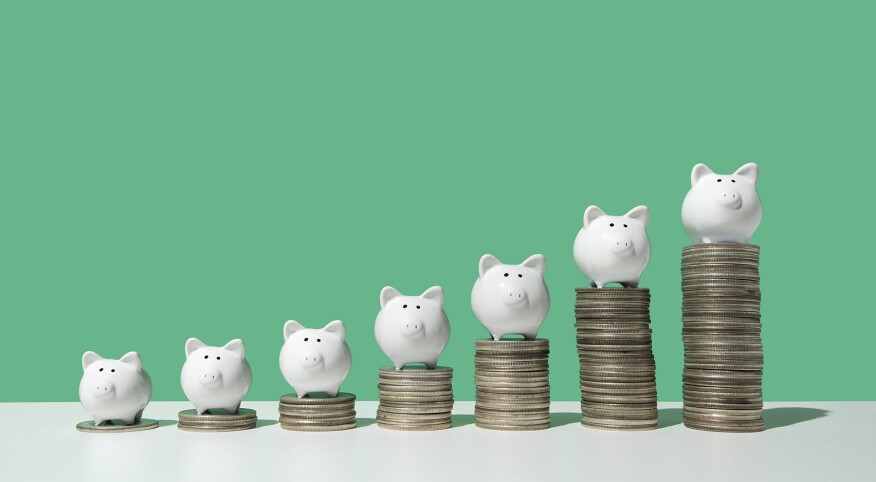My husband Julien and I have been saving money since we met. We blog about saving money on our award-winning website, rich & REGULAR, because we love inspiring others to do the same. When we paid off $200,000 of debt in five years, it was fueled by the consistency of a biweekly paycheck. But I quit my job in February 2020 to become a full-time entrepreneur and our income became inconsistent. The pandemic hit in March and everything changed. It forced me to rethink almost every aspect of my life, including the way I achieve my savings goals when my future earnings are unclear. I want to share those insights with you.
I’ve always found it easier to save money when the goal is crystal clear. For example, if I knew I needed $1,000 for a set of new tires, I could do some quick math and figure out how much to put aside each week. Or if I knew I wanted to go on a girl’s trip, I could plug in the exact travel dates and estimate a price. But most days, it feels impossible to imagine what life post-COVID will look like. Every time I get my hopes up about when things will return to normal, another surge of coronavirus cases pushes the timeline back.
Pull out your smart phone and take a look at how many apps come with a monthly or yearly fee. In 2019, Americans spent an average of $640 on digital subscriptions alone, which is more than the recent stimulus checks!
It’s much harder to save when I don’t know what I’m saving for. When you add a shaky economy to it, it just adds more guilt and less-than-realistic expectations. Thankfully, experience is the best teacher, and after enduring the 2008 financial crisis, I learned a few tricks that help me continue to save money during times of great uncertainty.
Set shorter-term goals
The people who have a habit of achieving long-term goals are really just setting a bunch of short-term goals and stringing them together. Your brain is actually wired to enjoy instant gratification and rewards — use that to your advantage! Try mini, time-bound challenges like “No Spend Wednesdays” during the month of February or saving $3 a day during the month of March. These little challenges are a great incentive to look for all the opportunities you can save. If you need some creative inspiration about where you can trim, here’s a great article with 99 ways to save money. Start small and make sure you celebrate once each challenge is met!
Audit your digital subscriptions
One of the downsides to setting short-term goals is that they won’t always capture recurring expenses, like subscription services. I love subscriptions because they’re convenient, but when it’s time to shave expenses they’re usually the first thing to go. I usually don’t cut all of them, but I always discover one or two that I don’t remember signing up for. In fact, cancelling subscriptions is my favorite passive way to save because it’s like finding money I forgot I had. In 2020, I ended an old Pandora subscription, didn’t renew an Audible subscription and downgraded a few like Hulu and cloud storage.
But for the purposes of this exercise, I look beyond digital subscriptions and consider anything that has a recurring fee as a subscription. It’s important that when you review your accounts, you look across a longer time horizon like 6 months or a year so you capture quarterly or annual payments for expenses like car insurance or Amazon Prime.
Go line-by-line through your billing statements and ask yourself if each expense is necessary. If it isn’t, then cancel it. There’s no need to wait until it expires. Even if you’ve already paid for an annual fee for something like a news platform subscription, the company can often give you a prorated refund for the months you haven’t consumed if you call them.
If you decide to keep the expense, then see if you can get it cheaper. This extra step saves us hundreds of dollars every year. Reach out to the provider and ask if you are eligible for a discount. If they won’t help you, then call their competitor and see what they’re offering by way of a free trial or reduced bill overall.
Enroll in a round-up program
Round-up programs are my favorite way to actively save because I barely notice it’s happening. They work by rounding up your purchases to the nearest dollar and diverting the difference to your savings account. For example, if you buy a $1.75 coffee with your credit or debit card, that purchase is rounded up to $2.00 and the extra 25 cents goes into the account of your choice.
What I like about round-up apps is that saving becomes completely automated. Let’s face it, we’re all guilty of some quarantine-induced impulse shopping. So even if you’re buying something nonessential, you’re paying yourself at the same time. Several of the big banks offer this as an option with your checking account, but if that isn’t the case for you, there are many apps that you can use such as Acorns or Chime.
During these unprecedented times, the best thing you can give yourself is one less thing to worry about. It doesn’t matter what kind of saving goals you have, if you can make them small, repeatable and automated, you’ll have greater success in achieving them. By eliminating the automatic withdrawals from subscription services and adding the automated savings associated with round-up apps, you won’t have to think about saving anything.











